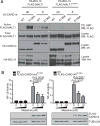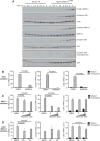Psoriasis mutations disrupt CARD14 autoinhibition promoting BCL10-MALT1-dependent NF-κB activation
- PMID: 27071417
- PMCID: PMC5810350
- DOI: 10.1042/BCJ20160270
Psoriasis mutations disrupt CARD14 autoinhibition promoting BCL10-MALT1-dependent NF-κB activation
Abstract
Inherited and de novo mutations in the CARD14 gene promote the development of psoriasis, an inflammatory disease of the skin. Caspase recruitment domain-containing protein 14 (CARD14) is a member of the CARMA protein family that includes the structurally related CARD11 adaptor that mediates NF-κB activation by antigen receptors. We investigated the mechanism by which CARD14 mutation in psoriasis activates NF-κB. In contrast with wild-type CARD14, CARD14(E138A) and CARD14(G117S) psoriasis mutants interacted constitutively with BCL10 and MALT1, and triggered BCL10- and MALT1-dependent activation of NF-κB in keratinocytes. These alterations disrupted the inhibitory effect of the CARD14 linker region (LR) on NF-κB activation by facilitating BCL10 binding. Therefore, psoriasis mutations activated CARD14 by a mechanism analogous to oncogenic CARD11 mutations in non-Hodgkin B cell lymphomas. CARD14(E138A) also stimulated MALT1 paracaspase activity and activated both ERK1/2 and p38α MAP kinases. Inhibition of MALT1 with mepazine reduced CARD14(E138A)-induced expression of specific psoriasis-associated transcripts in keratinocytes. Our results establish the mechanism whereby gain-of-function CARD14 variants, which induce psoriatic disease in affected individuals, activate pro-inflammatory signalling.
Keywords: NF-κB; caspase recruitment domain-containing protein 14 (CARD14); keratinocytes; mucosa-associated lymphoid tissue lymphoma translocation protein 1 (MALT1); psoriasis.
© 2016 The Author(s). published by Portland Press Limited on behalf of the Biochemical Society.
Figures




References
Publication types
MeSH terms
Substances
Grants and funding
LinkOut - more resources
Full Text Sources
Other Literature Sources
Medical
Molecular Biology Databases
Research Materials
Miscellaneous

